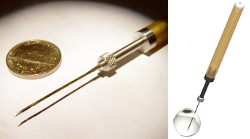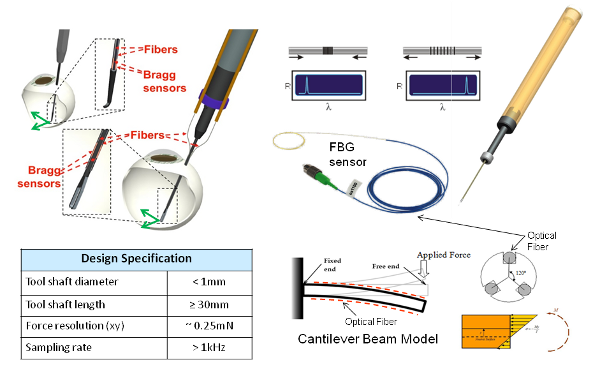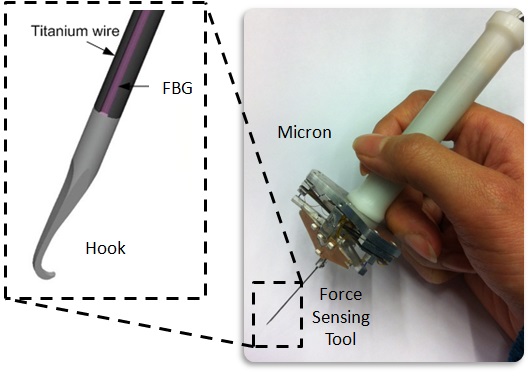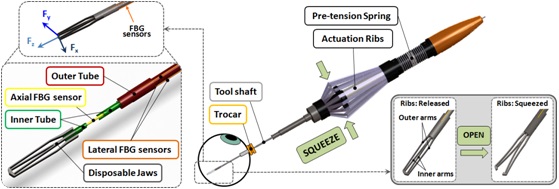Table of Contents
Force-Sensing Microsurgical Intruments
Vitreoretinal surgery is a technically demanding ophthalmologic discipline. It requires extremely delicate manipulation of retinal tissue. One of the main technical challenges in vitreoretinal surgery is the lack of force sensing since the surgical maneuvers fall below the human sensory threshold.
We are developing force-sensing instruments to measure very delicate forces exerted on eye tissue. Fiber optic sensors are incorporated into the tool shaft to measure forces distal to the sclera, to avoid the masking effect of forces between the tools and sclerotomy. We have built 2-DOF pick and forceps tools with the force resolution of 0.25 mN, as well as 3-DOF force sensing instruments with the axial force resolution of 0.7 mN and the transverse force resolution of 0.2 mN.
Project Goal
The goal is to develop sterilizable and clinically-compatible three degree of freedom (DOF) force-sensing instruments capable of sensing tool-to-tissue interaction forces commonly encountered in vitreoretinal surgery.
Approach
To deliver micro-force sensing inside of the eye, Fiber Bragg grating (FBG) sensors were chosen to achieve high resolution force measurements at the tip of a long thin tube. Bragg sensors consist of a grating formed inside of a photosensitive optical fiber by exposure to an intense optical interference pattern, which effectively creates a wavelength specific dielectric mirror inside of the fiber core. This characteristic Bragg wavelength shifts due to modal index or grating pitch change from physical deformation caused by strain or temperature change. FBGs can be incorporated into deformable structures to sense changes in force, pressure, and acceleration, with extremely high sensitivity. The fibers themselves have very small diameters (<160 μm), are immune to electrical or radio frequency noise, can be sterilized in various ways, and have excellent biocompatibility characteristics. Samples are acquired from the FBG interrogator at 2 kHz over a TCP/IP local network, and processed using custom software application (C++) based on the SAW framework.
Status and Results
2-DOF Tools
We have developed a family of force sensing instruments, including a 2-DOF force sensing microsurgical pick and a 2-DOF force sensing microsurgical forceps. Three fiber Bragg grating sensors are incorporated into the instrument shaft close to the distal end. Based on the axial strain due to tool bending, the instrument senses forces at the tip in the transverse plane, with a sensitivity of 0.25mN in the range of 0mN to 60mN. The design is theoretically temperature insensitive, but due to fabrication imperfections, temperature effects may be a factor. In such a case it can be minimized by proper calibration and biasing. The instruments can be used in freehand fashion or rigidly attached to the handle of a robot (e.g. Eye Robot2 or Micron).
3-DOF Tools
The main challenge is to incorporate high sensitivity axial force sensing. A sub-millimetric 3-DOF force sensing pick instrument has been developed based on fiber Bragg grating (FBG) sensors. The configuration of the four FBG sensors is arranged to maximize the decoupling between axial and transverse force sensing. A super-elastic nitinol flexure is designed to achieve high axial force sensitivity. An automated calibration system was developed for repeatability testing, calibration, and validation. Experimental results demonstrate a FBG sensor repeatability of 1.3 pm. The linear model for calculating the transverse forces provides an accurate global estimate. While the linear model for axial force is only locally accurate within a conical region with a 30° vertex angle, a second-order polynomial model can provide a useful global estimate for axial force. Combining the linear model for transverse forces and nonlinear model for axial force, the 3-DOF force sensing instrument can provide sub-millinewton resolution for axial force and a quarter millinewton for transverse forces. Validation with random samples show the force sensor can provide consistent and accurate measurement of three dimensional forces.
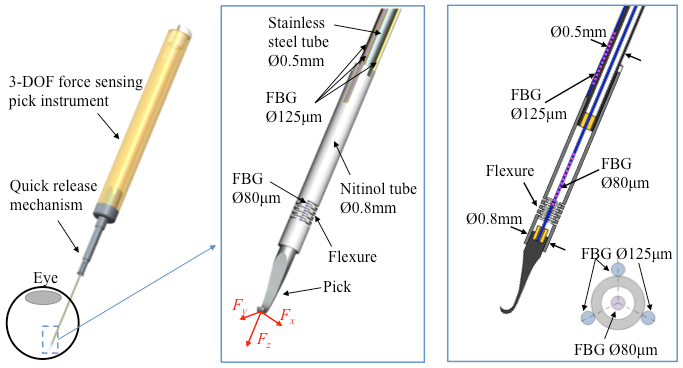

Multi-Function Force Sensing Tools and Variable Admittance Robot Control
During a freehand manipulation, the surgeon can often sense the contact force at the sclera entry point, and utilizes it as an important indicator to guide the desired motion, e.g. RCM and tool coordination. However, the stiffness of the Steady-Hand Eye Robot attenuates the user perceptible level of the sclera force, inducing undesired large sclera forces. We devised a multi-function force sensing instrument that can sense not only the sclera force in transverse directions, but also the location of the sclera contact point on the tool shaft. This new multi-function force sensing instrument enables a variable admittance robot control to provide an intuitive robot behavior. By varying the robot admittance, the robot behavior can continuously transit from an adaptive virtual fixture mode that enforces RCM and adapts to the current location of the sclerotomy site, to a force scaling mode that provides scaled feedback of the sclera force as well as the ability to reposition the eye. Experiments are conducted to calibrate the new multi- function force sensing instrument, to calibrate the tool tip position with respect to the robot, and to evaluate the force sensor as well as the proposed robot control algorithm. Preliminary results show the potential to increase safety, as well as to enhance the usability and capability of the robotic assistant system.
Future Plan
- Fabry-Perot-based 3-DOF force sensing instrument
- Further evaluation in in vivo experiments
Project Personnel
| JHU Whiting School | JHU Hospital, Wilmer Eye Institute |
|---|---|
| Dr. Russell Taylor | Dr. James Handa |
| Dr. Iulian Iordachita | Dr. Peter Gehlbach |
| Dr. Jin Kang | Nathan Cutler |
| Xingchi He | |
| Marcin Balicki | |
| Xuan Liu | |
| Berk Gonenc |
Group Alumni
- Dr. Laura Pinni
- Sarah Sunshine
- Ismail Kuru (TUM)
- Zhenglong Sun (Nanyang Technological University, Singapore)
- Albert Ho (CalTech)
- Mark Finkelstein
- Yi Yang
Funding
- NIH - 1 R01 EB 007969-01 A1
- NSF - EEC9731748
- JHU - Internal funds
Affiliated labs
Publications
- B. Gonenc, P. Gehlbach, J. Handa, R. H. Taylor, and I. Iordachita, “Force-Sensing Microneedle for Assisted Retinal Vein Cannulation,” in Proc. IEEE SENSORS 2014, 2014, accepted.
- X. He, P. Gehlbach, J. Handa, R. Taylor, and I. Iordachita, “Toward Robotically Assisted Membrane Peeling with 3-DOF Distal Force Sensing in Retinal Microsurgery,” in 36th Annual International Conference of the IEEE Engineering in Medicine and Biology Society (EMBC'14), Chicago, USA, Aug. 26-30, 2014, accepted.
- A. Gupta, B. Gonenc, M. Balicki, K. Olds, J. Handa, P. Gehlbach, R. H. Taylor, and I. Iordachita, “Human Eye Phantom for Developing Computer and Robot-Assisted Epiretinal Membrane Peeling,” in 36th Annual International Conference of the IEEE Engineering in Medicine and Biology Society (EMBC'14), Chicago, USA, Aug. 26-30, 2014, accepted.
- X. He, P. Gehlbach, J. Handa, R. Taylor, and I. Iordachita, “ Development of a Miniaturized 3-DOF Force Sensing Instrument for Robotically Assisted Retinal Microsurgery and Preliminary Results,” IEEE RAS/EMBS International Conference on Biomedical Robotics and Biomechatronics(BioRob'14), Aug. 12-15, Sao Paulo, 2014, accepted.
- B. Gonenc, P. Gehlbach, J. Handa, R. H. Taylor, and I. Iordachita, “Motorized Force-Sensing Micro-Forceps with Tremor Cancelling and Controlled Micro-Vibrations for Easier Membrane Peeling,” IEEE RAS/EMBS International Conference on Biomedical Robotics and Biomechatronics(BioRob'14), Aug. 12-15, Sao Paulo, 2014, accepted.
- X. He, M. Balicki, P. Gehlbach, J. Handa, R. Taylor, and I. Iordachita, “A Multi-Function Force Sensing Instrument with Variable Admittance Robot Control for Retinal Microsurgery,” IEEE International Conference on Robotics and Automation (ICRA), Hongkong, China, May 31-June 7, 2014. (Finalist - Best Student Paper Award)
- B. Gonenc, E. Feldman, P. Gehlbach, J. Handa, R. H. Taylor, and I. Iordachita, “Towards Robot-Assisted Vitreoretinal Surgery: Force-Sensing Micro-Forceps Integrated with a Handheld Micromanipulator,” IEEE International Conference on Robotics and Automation (ICRA), Hongkong, China, May 31-June 7, 2014.
- X. He, J. Handa, P. Gehlbach, R. Taylor, and I. Iordachita, “A Sub-Millimetric 3-DOF Force Sensing Instrument with Integrated Fiber Bragg Grating for Retinal Microsurgery,” IEEE Transactions on Biomedical Engineering, vol. 61, no. 2, pp. 522 – 534, 2014.
- B. Gonenc, J. Handa, P. Gehlbach, R. H. Taylor, and I. Iordachita, “Design of 3-DOF Force Sensing Micro-Forceps for Robot Assisted Vitreoretinal Surgery,” in 35th Annual International Conference of the IEEE Engineering in Medicine and Biology Society (EMBC'13), Osaka, Japan, Jul. 3-7, 2013, pp. 5686-5689.
- X. He, M. Balicki, P. Gehlbach, J. Handa, R. Taylor, and I. Iordachita, “A Novel Dual Force Sensing Instrument with Cooperative Robotic Assistant for Vitreoretinal Surgery,” IEEE International Conference on Robotics and Automation (ICRA), Karlsruhe, Germany, May 6-10, 2013, pp. 213-218.
- B. Gonenc, J. Handa, P. Gehlbach, R. H. Taylor, and I. Iordachita, “A Comparative Study for Robot Assisted Vitreoretinal Surgery: Micron vs. the Steady-Hand Robot,” IEEE International Conference on Robotics and Automation (ICRA), Karlsruhe, Germany, May 6-10, 2013, pp. 4832 - 4837.
- B. Gonenc, M. A. Balicki, J. Handa, P. Gehlbach, C. N. Riviere, R. H. Taylor, and I. Iordachita, “Preliminary Evaluation of a Micro-Force Sensing Handheld Robot for Vitreoretinal Surgery,” in Proc. IROS 2012, Vilamoura, Algarve, Portugal, Oct. 7-12, 2012, pp. 4125-4130.
- İ. Kuru, B. Gonenc, M. Balicki, J. Handa, P. Gehlbach, R. H. Taylor, and I. Iordachita, “Force Sensing Micro-Forceps for Robot Assisted Retinal Surgery,” in International Conference of the IEEE Engineering in Medicine and Biology Society (EMBC'12), 2012, pp. 1401–1404.
- X. Liu, I. Iordachita, X. He, R. Taylor, and J. U. Kang, “Miniature fiber-optic force sensor based on low-coherence Fabry-Pérot interferometry for vitreoretinal microsurgery,” Biomedical Optics Express, vol. 3, no. 5, pp. 1062–1076, May 2012.
- S. Sunshine, M. Balicki, X. He, K. Olds, J. U. Kang, P. Gehlbach, R. Taylor, I. Iordachita, and J. T. Handa, “A Force-Sensing Microsurgical Instrument That Detects Forces Below Human Tactile Sensation,” RETINA, 2012.
- X. He, M. Balicki, J.U. Kang, P. Gehlbach, J. Handa, R. Taylor, and I. Iordachita, “Force sensing micro-forceps with integrated fiber Bragg grating for vitreoretinal surgery,” 2012 SPIE Photonics West
- X. Liu, I. Iordachita, X. He, R. Taylor, and J.U. Kang, “Miniature fiber-optic force sensor for vitreoretinal microsurgery based on low-coherence Fabry-Pérot interferometry,” 2012 SPIE Photonics West 8218-82180W
- I. Iordachita, Z. Sun, M. Balicki, J.U. Kang, S.J. Phee, J. Handa, P. Gehlbach, and R. Taylor, “A sub-millimetric, 0.25 mN resolution fully integrated fiber-optic force-sensing tool for retinal microsurgery,” International Journal of Computer Assisted Radiology and Surgery, Vol. 4, Jun. 2009, pp. 383-90.
- Z. Sun, M. Balicki, J.U. Kang, J. Handa, R. Taylor, and I. Iordachita, “Development and preliminary data of novel integrated optical micro-force sensing tools for retinal microsurgery,” 2009 IEEE International Conference on Robotics and Automation, May. 2009, pp. 1897-1902.
